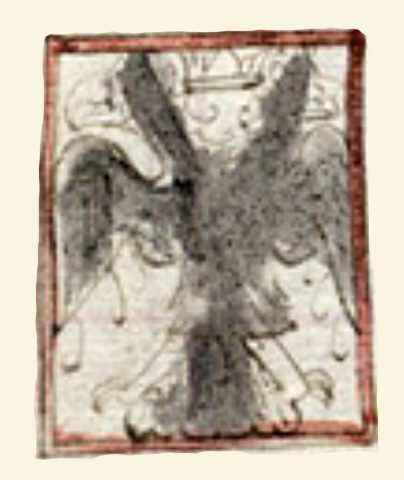tlahuiztli (CST26)
This painting of the simplex glyph for the term tlahuiztli (coat of arms) shows a Hapsburg coat of arms, which pertained to the king in Spain, but here it was purchased by the Indigenous community to have it placed in the audiencia (a Spanish loanword referring to a judicial chamber or meeting room of the Indigenous town council).
Stephanie Wood
The embrace of this symbol of Spanish colonial power by the Indigenous rulers of this town may seem ironic, but by cooperating with the colonial enterprise their town was recognized and local rule (to some degree) continued. As Kevin Terraciano points out in his study of the Codex Sierra (2021, 151), the use of tlahuiztli, which meant arms or insignia for Nahuas, is used in this manuscript to refer to the coats of arms of the king and the local bishop. The concept embraced this new type of insignia. Eventually, many members of the Mesoamerican elite would apply to have their own coats of arms. See Robert Haskett, “Paper Shields: The Ideology of Coats of Arms in Colonial Mexican Primordial Titles,” Ethnohistory (1996).
Stephanie Wood
ytlaviz
itlahuiz
Stephanie Wood
1550–1564
Jeff Haskett-Wood
insignias, escudos de armas, águila bicéfala de Habsburgo

tlahuiz(tli), coat of arms, https://nahuatl.wired-humanities.org/content/tlahuiztli
escudo de armas
Stephanie Wood
Códice Sierra-Texupan, plate 26, page dated 1559. Origin: Santa Catalina Texupan, Mixteca Alta, State of Oaxaca. Kevin Terraciano has published an outstanding study of this manuscript (Codex Sierra, 2021), and in his book he refers to alphabetic and “pictorial” writing, not hieroglyphic writing. We are still counting some of the imagery from this source as hieroglyphic writing, but we are also including examples of “iconography” where the images verge on European style illustrations or scenes showing activities. We have this iconography category so that such images can be fruitfully compared with hieroglyphs. Hieroglyphic writing was evolving as a result of the influence of European illustrations, and even alphabetic writing impacted it.
https://bidilaf.buap.mx/objeto.xql?id=48281&busqueda=Texupan&action=search
The Biblioteca Digital Lafragua of the Biblioteca Histórica José María Lafragua in Puebla, Mexico, publishes this Códice Sierra-Texupan, 1550–1564 (62pp., 30.7 x 21.8 cm.), referring to it as being in the “Public Domain.” This image is published here under a Creative Commons license, asking that you cite the Biblioteca Digital Lafragua and this Visual Lexicon of Aztec Hieroglyphs.





